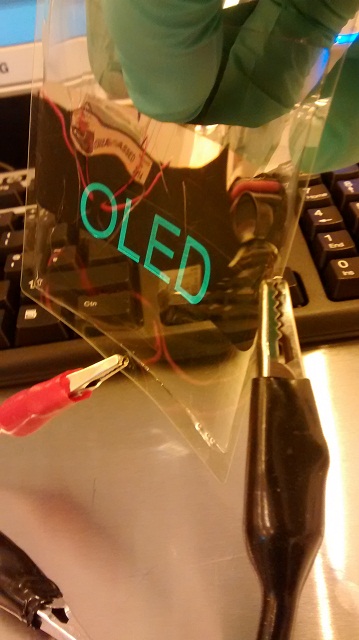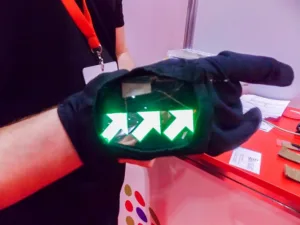Research firm IDTechEx holds a printed electronics event twice a year: once in Berlin, and once in Santa Clara. We attended the European event at the end of April, which had lots of coverage of emissive quantum dots, micro-LEDs and other emerging and existing display technologies. One of these was from Polar OLED, which is developing fully printed OLED displays.

 Polar OLED’s devices are stable while being flexedToday’s ‘solution-processed’ OLEDs still use vapour deposition for the final layers, such as the metal cathode. This is because of the difficulty of forming multilayer stacks with conventional solution processing: applying subsequent layers tends to dissolve those already present. Polar OLED has a method to deal with that challenge, though.
Polar OLED’s devices are stable while being flexedToday’s ‘solution-processed’ OLEDs still use vapour deposition for the final layers, such as the metal cathode. This is because of the difficulty of forming multilayer stacks with conventional solution processing: applying subsequent layers tends to dissolve those already present. Polar OLED has a method to deal with that challenge, though.
Stuart Kitney is the lead scientist at Polar OLED, and we talked to him both at the IDTechEx Show and as a follow up afterwards. Polar OLED’s current aim is to produce low-cost, even disposable, OLED displays. The eventual aim is to create a fully printed active matrix display, but for now Polar is addressing areas that are achievable today.
Kitney explained that the firm was founded in 2008 by Steve Kelly and Mary O’Neill, as a spin-off from the University of Hull in the UK. Recently, it has moved to a new home in Leeds. It also works with the National Printable Electronics Centre in Sedgefield: this is part of the UK’s Centre for Process Innovation (CPI).
The company’s new OLED production process exploits Polar’s background in liquid crystals. The OLEDs are solution processed, and use the firm’s understanding of liquid crystals. Specifically, Polar OLED uses liquid crystal-based polymer networks (‘CrystOLED’) to print the OLED layers, or cast them using solvents. These layers can then be exposed to ultraviolet radiation to cure them, using a standard process that has been used in printing for many years. The result is an insoluble layer, to which other layers can be added using different colour materials or patterns. The insoluble layer prevents the other layers dissolving each other.
The use of CrystOLED means that the OLED materials can be aligned within the thin film, like liquid crystals, to improve factors such as efficiency and light output. Although every material is different, Kitney said that efficiency is about 25% higher in Polar OLED’s displays than existing solution-processed OLEDs. He couldn’t go into too much detail about the structure, but said that both top- and bottom-emitting OLEDs are of interest.
Polar OLED creates its own fluorescent emissive OLED materials, using its chemistry division at the University of Hull. This means that wavelengths can be finely tuned for optimal colour output which the firm sees as important for passive displays. Tuning wavelengths enables Polar OLED to display colours that would otherwise not be possible but might be required by customers, such as Coca-Cola red.
Although the firm is creating its own materials, it is having the same issues with blue OLED lifetime as everyone else. The accepted solution appears to be double pixellation of blue, with circuitry to compensate.
Polar OLED’s aim is to move to a roll-to-roll process in the future, but right now is using sheet-fed manufacturing, which gives more control over the substrate. Kitney said that passive OLED displays will be created within the next six months.
A prototype demonstrator built for WTS 2015, which reached a peak brightness of 2,500 cd/m² at 6V. Polar OLED’s standard brightness is around 500 cd/m².– Tom Allen

